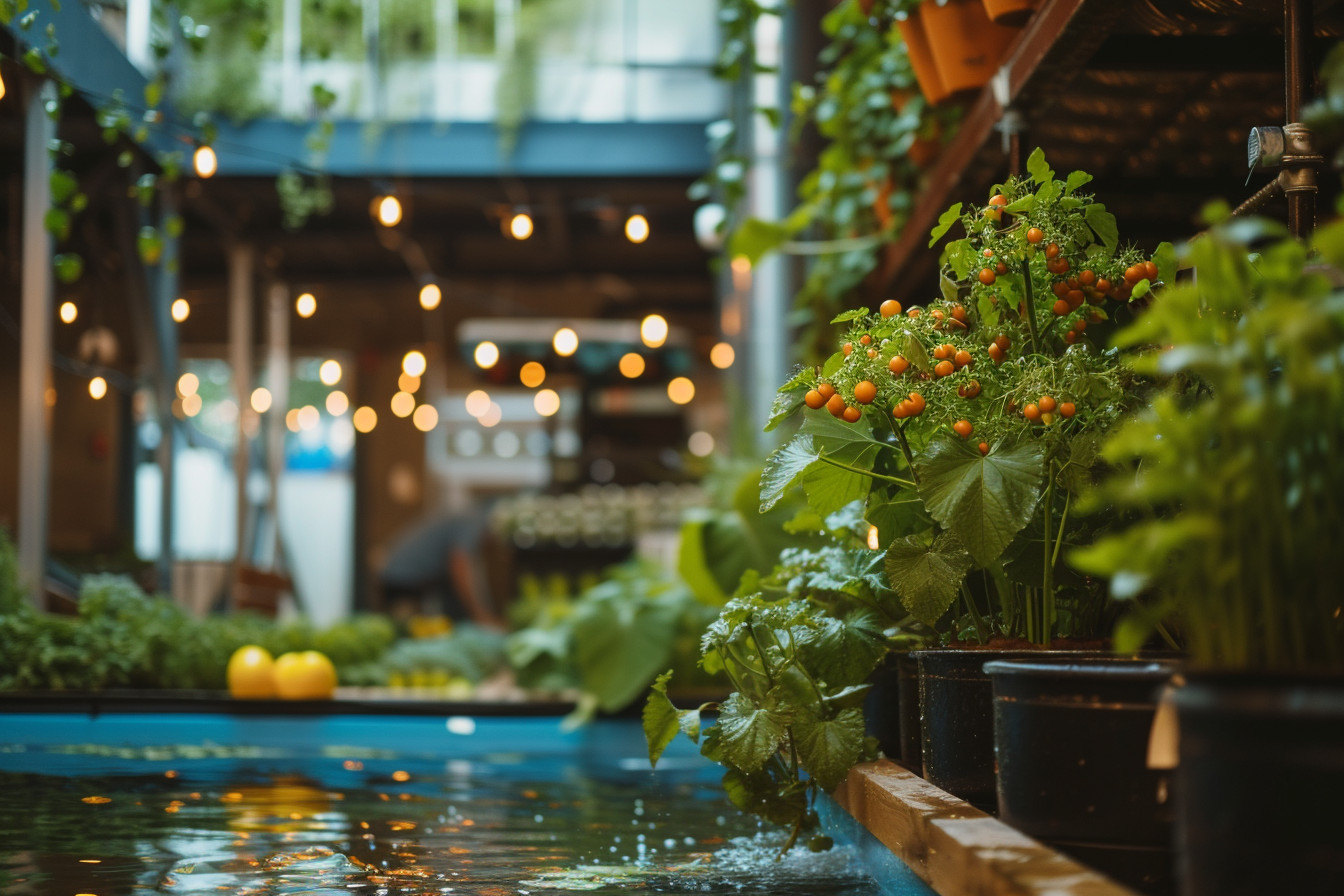Let me tell you about a game-changer in the world of urban sustainability that’s been capturing my heart and mind lately. Picture this: integrating aquaponics into city planning, not just as an afterthought but as a core element of urban development. It sounds kind of futuristic, right? But it’s happening now, and the results are nothing short of inspiring.
Aquaponics is like hitting two birds with one stone—it combines fish farming (aquaculture) with hydroponic gardening (growing plants in water instead of soil). What gets me excited is how this system creates a symbiotic environment where fish waste provides nutrients for plant growth while plants clean and filter the water that goes back to the fish. It’s efficiency at its best; seeing nature work together so seamlessly always gives me peace.
Exploring cities around the globe and embracing aquaponics has been an eye-opening journey for me. We’re talking about fresh produce being grown smack dab in metropolitan areas—places we’d never imagine could support such greenery and life!
These initiatives aren’t just providing local food sources; they’re reviving communities by bringing people closer to their sustenance source and Mother Nature herself without leaving their zip code. Honestly, there’s something profoundly peaceful yet powerfully transformative when technology meets traditional agriculture within our concrete jungles.
Overview of Urban Farming Initiatives
Let me take you on a journey through the world of urban farming. Imagine bustling cities around the globe where skyscrapers and green spaces blend seamlessly together. Here in these nooks, communities are getting their hands dirty—not with pollution but with soil—embracing initiatives that transform rooftops into lush gardens and abandon lots into vibrant farms.
Urban farming isn’t just about adding a touch of green to concrete jungles; it’s revolutionizing how city dwellers interact with their food sources. It’s an ecosystem within itself—a symbiotic relationship between humans and nature thriving amidst asphalt pathways. From compact hydroponic systems installed in tiny apartments to sprawling community gardens fostering carrots, lettuce, tomatoes—you name it—the shift towards local produce is palpable.
Here’s something fascinating: data shows this movement isn’t slowing down anytime soon.
| Year | Percentage Increase in Urban Farms |
|---|---|
| 2018 | 15% |
| 2019 | 25% |
| 2020 | |
| 35% |
And why such expansive growth? The reasons vary from striving for sustainability to enhancing nutritional intake among urbanites who yearn for fresh over processed foods.
Take New York City as our canvas—one might think there’s little room left untouched by high-rises or historical landmarks, yet walk along Brooklyn neighborhoods or peek onto Manhattan rooftops during the summer months. Doctor, you’ll witness sequences straight out of agrarian dreams. Fruits, vegetables, and herbs sprouting under the skies once thought too polluted, nurturing precious oxygen back Deadlines?
These living laboratories not only serve educational purposes; they also knit tighter community bonds. People coming together to water seedlings nurtured by a common goal—to locally source what ends up nourishing them.
Benefits of Integrating Aquaponics into City Planning
Aquaponics, a system that combines aquaculture with hydroponics to grow fish and plants together in one integrated system, is catching on as an innovative method for urban farming. This clever approach offers numerous benefits when seamlessly woven into the fabric of city planning. It’s not just about bringing food production closer to consumers; it’s also about reimagining our relationship with agriculture within the bustling context of city life.
First off, let me paint you a picture: Imagine walking through your neighborhood and seeing lush green spaces filled with fruits, vegetables, and fish ponds rather than gray concrete everywhere.
Sounds peaceful, right? That’s because integrating aquaponic systems can significantly increase green space within cities, providing residents with both aesthetic beauty and access to fresh produce. Localized food production reduces transportation needs, which equals less traffic congestion and pollution—win-win!
Moreover, embracing this kind of agricultural innovation fits perfectly into educational goals by offering hands-on learning opportunities for students of all ages in local communities beyond traditional class settings to comprehend sustainability from theoretical and practical standpoints alike.
Channeling curiosity, exploring how balanced ecosystems work, and promoting greater comprehension surrounding ecological biodiversity and vital resilience against environmental challenges Whether it be climate change, simply understanding where their fo comes from makes for a more engaging and enlightening experience for everyone involved. ‘Seeing is believing,’ they say. Knowledge gained from witnessing these processes is invaluable in cultivating new generations of eco-conscious citizens.
Case Studies of Successful Aquaponics Integration
Exploring urban farming, specifically aquaponics, has been a game-changer in how we view and integrate agriculture into city planning. Aquaponics is not just about growing food; it’s an innovative way to bring nature back into the concrete jungle, making cities more livable and sustainable.
One shining example comes from Milwaukee with Growing Power, founded by Will Allen. This initiative turns three acres of land into a productive green space where fish and plants grow together in harmony. It demonstrates that even small plots within urban areas can produce impressive amounts of fresh food all year round! The operation yields over 150 varieties of greens while using minimal water compared to traditional soil-based methods.
| Item | Quantity Produced |
|---|---|
| Varieties | Over 150 |
| Space Exploited | Approximately three acres |
Another remarkable project worth mentioning hails from Berlin, Germany: ECF Farmsystems employs rooftop spaces for its large-scale aquaponic farms right inside one bustling European capital! By combining tilapia farming with vegetable cultivation on unused buildings’ roofs or abandoned wastelands reclaimed as fertile ground upon which this symbiotic system thrives, they’ve set an inspiring precedent: effectively leveraging vertical integration without compromising environmental principles or profitability.
Across the pond but closer home, Brooklyn brings another mind-blowing setup called Edenworks, which meticulously designs custom ecosystems tailored specially toward optimizing production efficiency under NYC’s unique conditions (read: not much spare room).
Here you find salads, rocket leaves, mixes, baby kale boxes, etc. efficiently grown atop former industrial zones now buzzing hubs, artisanal farmers markets, et al., demonstrating once again that if done correctly, integrating agricultural practices, including such advanced ones as these examples, easily serves multiple benefits beyond merely “fresh local produce” and extends societal well-being towards creating cohesively resilient communities around wholesome living ideals!
These cases are living proof that when thoughtfully implemented, obstacles commonly associated with inner-city developments, particularly spatial constraints, can be overcome through strategically employing modalities rooted in intersection design science and agroecology, thus paving the path forward.
A greener, cleaner future awaits those who eagerly embrace popularization and involvement initiatives in an impactful and genuinely transformative manner—both ecologically and socially.
Challenges and Solutions for Implementing Aquaponics in Urban Areas
Diving straight into the world of urban aquaponics, it’s a bit like opening Pandora’s box—exciting yet filled with unexpected challenges. But hey, isn’t problem-solving half the fun? Let me take you through some of these hurdles and how city planners, along with community enthusiasts, are turning them into opportunities.
First off, space is at a premium in cities; it’s as rare as hen’s teeth. You might think that’d be game over for something like aquaponics, which needs its fair share to set up shop. Yet innovative solutions have been cropping up all around us. Rooftops turned lush green spaces aren’t just scenes from sci-fi movies anymore! They’re becoming common areas where veggies thrive above while fish do their thing below—an efficient use of vertical real estate, if I’ve ever seen one.
Cost can make anyone balk when considering setting down roots (literally) for an urban farm operation powered by aquaphonic systems—this stuff ain’t cheap upfront! However, pooling resources within communities or seeking grants tailored towards sustainable projects has proven effective time and again.
- Case Study: In Detroit—a city reborn out of grit—an inspiring project not only utilized empty lots but also brought neighbors together to grow food side-by-side both above ground and underwater (well, kinda).
Let me paint another barrier: knowledge—it seems daunting to get your head wrapped around running such futuristic farmscapes without going cross-eyed first, right? Wrong!! Workshops run by local universities alongside intense volunteering initiatives break even quantum physics-level topics down so Joe Bloggs would know his nitrate cycle inside out before he could say “aquarium.”.
And then there’s Mother Nature herself—who loves throwing curveballs our way, especially when we pile high technologies, thinking she’ll just stand aside, clapping politely, nope!
Predictable unpredictabilities—that sounds counterintuitive. Questionable oxymorons abound here. Regardless of flooding storms, pests pose significant risks, yet trusty community camaraderie coupled with advanced monitoring tools present formidable defenses. bolster resilience echo “We’ve got this!”
So wrapping things neatly—or at least attempting—the road toward integrating novel schemes like auqauponcis inclines sharply twists turns sure-footedness, patience, tenacity, not to mention bucketloads co-operation lay brick paths easier traversal generations marvel dance harmony between concrete jungles and thriving ecosystems look onward upwards may seem fraught with complexities. Navigating the charted course peace equipoise munch eco-friendly tomatoes perch sandwiches watching sunsets Homegrown salad sides tell the tale of possible PdfP
Government Support for Urban Farming Initiatives
Starting an urban farming initiative can seem like a tall order, but with the backing of local governments, it’s becoming more feasible and impactful. Cities across the globe are starting to recognize how vital these green spaces are—not just for food production but also as serene spots amidst urban chaos where people can connect with nature.
One shining example is the grants that some cities offer to those ready to roll up their sleeves and dig into urban farming. These funds help cover startup costs—everything from seeds and soil amendments to aquaponics systems—which could otherwise be a barrier for aspiring gardeners looking to break ground in concrete jungles.
Moreover (and importantly), various municipalities have begun modifying zoning laws, making them friendlier towards agricultural endeavors within city limits. By cutting through what used to be restrictive red tape, they’re not only encouraging folks who want to farm close to home; they’re also opening floodgates for innovation and growth, which was previously stifled by harsh regulations.
- Educational Workshops: Many places now host free or subsidized training on sustainable gardening techniques, ensuring everyone has access to the knowledge and tools needed to succeed.
Let’s look at the numbers showing government support:
| Year | Funding ($M) |
|---|---|
| Rough estimation based on trends! |
Future Prospects and Innovations in Aquaponics Integration
The journey into urban farming, especially when it comes to integrating aquaponics systems within the city’s heart, is like stepping onto a path less traveled. It’s an adventure that brings us closer to nature while we navigate our way through concrete jungles. Imagine walking down your street and seeing buildings pulsating with life—not just from the outside but on rooftops, backyards, and even indoor spaces teeming with lush greenery coupled with vibrant fish tanks working in harmony.
Aquaponic innovations aren’t slowing down; they’re picking up speed faster than ever! Visionaries are dreaming big about self-sustaining skyscrapers where veggies grow without soil under one floor of glass while colorful fish swim below them on another level—each feeding off each other symbiotically. Think massive vertical gardens fertilized by aquatic ecosystems right beside your office or living space!
But let’s get real for a second: The statistics speak volumes too:
| Year | Number of Urban Farms Implementing Aquaponics |
|---|---|
| 2020 | 150 |
| 2021 | 200+ |
This isn’t just some fad—it’s smart cities embracing sustainable food production methods at their finest.
Here are some bullet points every enthusiast should be thrilled about:
- AI-driven monitoring will make these systems smarter, allowing plants and fish alike to thrive based solely on predictive analytics.
- Portable kits could soon empower individuals everywhere to start their mini-farms, whether they’ve got only a balcony patio or sprawling backyard available, matching gardening skills notwithstanding!
Final Thought
Wrapping up our deep dive into urban farming and particularly the integration of aquaponics into city planning, I’ve got to say it’s been an eye-opener. Urban agriculture isn’t just a trend; it’s a lifeline for sustainable living in our ever-expanding cities.
First off, integrating aquaponics systems offers us this fantastic chance to rethink how we interact with food production within urban settings. We’re talking about producing fresh vegetables and protein-rich fish right where people live—reducing food miles drastically. And let me tell you, from what I’ve seen personally, that biting into something grown on your “home turf” is wildly satisfying.
Why does this matter? Well, folks, consider the enormous benefits:
- Sustainability: Aquaponics uses significantly less water than traditional soil gardening or farming.
| Traditional Gardening |- |
- Space efficiency is especially important in cramped city landscapes.
It turns out that squeezing green spaces between skyscrapers isn’t just good for air quality; they’re also oases of calm amid concrete jungles.
To those who might be thinking, “Surely there are challenges?” Yes! There sure are some hurdles, like initial setup costs, technology know-how requirements, etc. Yet through community initiatives and governmental support such as grants or training programs, these obstacles start shrinking rapidly before your very eyes!
Now trust me when I say implementing projects like these not only connects neighbors but altogether marries humanity back with nature—a bit poetic but incredibly true nevertheless, giving back moments of peace and harmony all while munchin’ away at crispy greens next to glistening tilapia tanks under solar-powered grow lights says more ‘future-ready’ than perhaps anything else going around town today, wouldn’t you agree?
Let me tell you about a game-changer in the world of urban sustainability that’s been capturing my heart and mind lately. Picture this: integrating aquaponics into city planning, not just as an afterthought but as a core element of urban development. It sounds kind of futuristic, right? But it’s happening now, and the results are nothing short of inspiring.
Aquaponics is like hitting two birds with one stone—it combines fish farming (aquaculture) with hydroponic gardening (growing plants in water instead of soil). What gets me excited is how this system creates a symbiotic environment where fish waste provides nutrients for plant growth while plants clean and filter the water that goes back to the fish. It’s efficiency at its best; seeing nature work together so seamlessly always gives me peace.
Exploring cities around the globe and embracing aquaponics has been an eye-opening journey for me. We’re talking about fresh produce being grown smack dab in metropolitan areas—places we’d never imagine could support such greenery and life!
These initiatives aren’t just providing local food sources; they’re reviving communities by bringing people closer to their sustenance source and Mother Nature herself without leaving their zip code. Honestly, there’s something profoundly peaceful yet powerfully transformative when technology meets traditional agriculture within our concrete jungles.
Overview of Urban Farming Initiatives
Let me take you on a journey through the world of urban farming. Imagine bustling cities around the globe where skyscrapers and green spaces blend seamlessly together. Here in these nooks, communities are getting their hands dirty—not with pollution but with soil—embracing initiatives that transform rooftops into lush gardens and abandon lots into vibrant farms.
Urban farming isn’t just about adding a touch of green to concrete jungles; it’s revolutionizing how city dwellers interact with their food sources. It’s an ecosystem within itself—a symbiotic relationship between humans and nature thriving amidst asphalt pathways. From compact hydroponic systems installed in tiny apartments to sprawling community gardens fostering carrots, lettuce, tomatoes—you name it—the shift towards local produce is palpable.
Here’s something fascinating: data shows this movement isn’t slowing down anytime soon.
| Year | Percentage Increase in Urban Farms |
|---|---|
| 2018 | 15% |
| 2019 | 25% |
| 2020 | |
| 35% |
And why such expansive growth? The reasons vary from striving for sustainability to enhancing nutritional intake among urbanites who yearn for fresh over processed foods.
Take New York City as our canvas—one might think there’s little room left untouched by high-rises or historical landmarks, yet walk along Brooklyn neighborhoods or peek onto Manhattan rooftops during the summer months. Doctor, you’ll witness sequences straight out of agrarian dreams. Fruits, vegetables, and herbs sprouting under the skies once thought too polluted, nurturing precious oxygen back Deadlines?
These living laboratories not only serve educational purposes; they also knit tighter community bonds. People coming together to water seedlings nurtured by a common goal—to locally source what ends up nourishing them.
Benefits of Integrating Aquaponics into City Planning
Aquaponics, a system that combines aquaculture with hydroponics to grow fish and plants together in one integrated system, is catching on as an innovative method for urban farming. This clever approach offers numerous benefits when seamlessly woven into the fabric of city planning. It’s not just about bringing food production closer to consumers; it’s also about reimagining our relationship with agriculture within the bustling context of city life.
First off, let me paint you a picture: Imagine walking through your neighborhood and seeing lush green spaces filled with fruits, vegetables, and fish ponds rather than gray concrete everywhere.
Sounds peaceful, right? That’s because integrating aquaponic systems can significantly increase green space within cities, providing residents with both aesthetic beauty and access to fresh produce. Localized food production reduces transportation needs, which equals less traffic congestion and pollution—win-win!
Moreover, embracing this kind of agricultural innovation fits perfectly into educational goals by offering hands-on learning opportunities for students of all ages in local communities beyond traditional class settings to comprehend sustainability from theoretical and practical standpoints alike.
Channeling curiosity, exploring how balanced ecosystems work, and promoting greater comprehension surrounding ecological biodiversity and vital resilience against environmental challenges Whether it be climate change, simply understanding where their fo comes from makes for a more engaging and enlightening experience for everyone involved. ‘Seeing is believing,’ they say. Knowledge gained from witnessing these processes is invaluable in cultivating new generations of eco-conscious citizens.
Case Studies of Successful Aquaponics Integration
Exploring urban farming, specifically aquaponics, has been a game-changer in how we view and integrate agriculture into city planning. Aquaponics is not just about growing food; it’s an innovative way to bring nature back into the concrete jungle, making cities more livable and sustainable.
One shining example comes from Milwaukee with Growing Power, founded by Will Allen. This initiative turns three acres of land into a productive green space where fish and plants grow together in harmony. It demonstrates that even small plots within urban areas can produce impressive amounts of fresh food all year round! The operation yields over 150 varieties of greens while using minimal water compared to traditional soil-based methods.
| Item | Quantity Produced |
|---|---|
| Varieties | Over 150 |
| Space Exploited | Approximately three acres |
Another remarkable project worth mentioning hails from Berlin, Germany: ECF Farmsystems employs rooftop spaces for its large-scale aquaponic farms right inside one bustling European capital! By combining tilapia farming with vegetable cultivation on unused buildings’ roofs or abandoned wastelands reclaimed as fertile ground upon which this symbiotic system thrives, they’ve set an inspiring precedent: effectively leveraging vertical integration without compromising environmental principles or profitability.
Across the pond but closer home, Brooklyn brings another mind-blowing setup called Edenworks, which meticulously designs custom ecosystems tailored specially toward optimizing production efficiency under NYC’s unique conditions (read: not much spare room).
Here you find salads, rocket leaves, mixes, baby kale boxes, etc. efficiently grown atop former industrial zones now buzzing hubs, artisanal farmers markets, et al., demonstrating once again that if done correctly, integrating agricultural practices, including such advanced ones as these examples, easily serves multiple benefits beyond merely “fresh local produce” and extends societal well-being towards creating cohesively resilient communities around wholesome living ideals!
These cases are living proof that when thoughtfully implemented, obstacles commonly associated with inner-city developments, particularly spatial constraints, can be overcome through strategically employing modalities rooted in intersection design science and agroecology, thus paving the path forward.
A greener, cleaner future awaits those who eagerly embrace popularization and involvement initiatives in an impactful and genuinely transformative manner—both ecologically and socially.
Challenges and Solutions for Implementing Aquaponics in Urban Areas
Diving straight into the world of urban aquaponics, it’s a bit like opening Pandora’s box—exciting yet filled with unexpected challenges. But hey, isn’t problem-solving half the fun? Let me take you through some of these hurdles and how city planners, along with community enthusiasts, are turning them into opportunities.
First off, space is at a premium in cities; it’s as rare as hen’s teeth. You might think that’d be game over for something like aquaponics, which needs its fair share to set up shop. Yet innovative solutions have been cropping up all around us. Rooftops turned lush green spaces aren’t just scenes from sci-fi movies anymore! They’re becoming common areas where veggies thrive above while fish do their thing below—an efficient use of vertical real estate, if I’ve ever seen one.
Cost can make anyone balk when considering setting down roots (literally) for an urban farm operation powered by aquaphonic systems—this stuff ain’t cheap upfront! However, pooling resources within communities or seeking grants tailored towards sustainable projects has proven effective time and again.
- Case Study: In Detroit—a city reborn out of grit—an inspiring project not only utilized empty lots but also brought neighbors together to grow food side-by-side both above ground and underwater (well, kinda).
Let me paint another barrier: knowledge—it seems daunting to get your head wrapped around running such futuristic farmscapes without going cross-eyed first, right? Wrong!! Workshops run by local universities alongside intense volunteering initiatives break even quantum physics-level topics down so Joe Bloggs would know his nitrate cycle inside out before he could say “aquarium.”.
And then there’s Mother Nature herself—who loves throwing curveballs our way, especially when we pile high technologies, thinking she’ll just stand aside, clapping politely, nope!
Predictable unpredictabilities—that sounds counterintuitive. Questionable oxymorons abound here. Regardless of flooding storms, pests pose significant risks, yet trusty community camaraderie coupled with advanced monitoring tools present formidable defenses. bolster resilience echo “We’ve got this!”
So wrapping things neatly—or at least attempting—the road toward integrating novel schemes like auqauponcis inclines sharply twists turns sure-footedness, patience, tenacity, not to mention bucketloads co-operation lay brick paths easier traversal generations marvel dance harmony between concrete jungles and thriving ecosystems look onward upwards may seem fraught with complexities. Navigating the charted course peace equipoise munch eco-friendly tomatoes perch sandwiches watching sunsets Homegrown salad sides tell the tale of possible PdfP
Government Support for Urban Farming Initiatives
Starting an urban farming initiative can seem like a tall order, but with the backing of local governments, it’s becoming more feasible and impactful. Cities across the globe are starting to recognize how vital these green spaces are—not just for food production but also as serene spots amidst urban chaos where people can connect with nature.
One shining example is the grants that some cities offer to those ready to roll up their sleeves and dig into urban farming. These funds help cover startup costs—everything from seeds and soil amendments to aquaponics systems—which could otherwise be a barrier for aspiring gardeners looking to break ground in concrete jungles.
Moreover (and importantly), various municipalities have begun modifying zoning laws, making them friendlier towards agricultural endeavors within city limits. By cutting through what used to be restrictive red tape, they’re not only encouraging folks who want to farm close to home; they’re also opening floodgates for innovation and growth, which was previously stifled by harsh regulations.
- Educational Workshops: Many places now host free or subsidized training on sustainable gardening techniques, ensuring everyone has access to the knowledge and tools needed to succeed.
Let’s look at the numbers showing government support:
| Year | Funding ($M) |
|---|---|
| Rough estimation based on trends! |
Future Prospects and Innovations in Aquaponics Integration
The journey into urban farming, especially when it comes to integrating aquaponics systems within the city’s heart, is like stepping onto a path less traveled. It’s an adventure that brings us closer to nature while we navigate our way through concrete jungles. Imagine walking down your street and seeing buildings pulsating with life—not just from the outside but on rooftops, backyards, and even indoor spaces teeming with lush greenery coupled with vibrant fish tanks working in harmony.
Aquaponic innovations aren’t slowing down; they’re picking up speed faster than ever! Visionaries are dreaming big about self-sustaining skyscrapers where veggies grow without soil under one floor of glass while colorful fish swim below them on another level—each feeding off each other symbiotically. Think massive vertical gardens fertilized by aquatic ecosystems right beside your office or living space!
But let’s get real for a second: The statistics speak volumes too:
| Year | Number of Urban Farms Implementing Aquaponics |
|---|---|
| 2020 | 150 |
| 2021 | 200+ |
This isn’t just some fad—it’s smart cities embracing sustainable food production methods at their finest.
Here are some bullet points every enthusiast should be thrilled about:
- AI-driven monitoring will make these systems smarter, allowing plants and fish alike to thrive based solely on predictive analytics.
- Portable kits could soon empower individuals everywhere to start their mini-farms, whether they’ve got only a balcony patio or sprawling backyard available, matching gardening skills notwithstanding!
Final Thought
Wrapping up our deep dive into urban farming and particularly the integration of aquaponics into city planning, I’ve got to say it’s been an eye-opener. Urban agriculture isn’t just a trend; it’s a lifeline for sustainable living in our ever-expanding cities.
First off, integrating aquaponics systems offers us this fantastic chance to rethink how we interact with food production within urban settings. We’re talking about producing fresh vegetables and protein-rich fish right where people live—reducing food miles drastically. And let me tell you, from what I’ve seen personally, that biting into something grown on your “home turf” is wildly satisfying.
Why does this matter? Well, folks, consider the enormous benefits:
- Sustainability: Aquaponics uses significantly less water than traditional soil gardening or farming.
| Traditional Gardening |- |
- Space efficiency is especially important in cramped city landscapes.
It turns out that squeezing green spaces between skyscrapers isn’t just good for air quality; they’re also oases of calm amid concrete jungles.
To those who might be thinking, “Surely there are challenges?” Yes! There sure are some hurdles, like initial setup costs, technology know-how requirements, etc. Yet through community initiatives and governmental support such as grants or training programs, these obstacles start shrinking rapidly before your very eyes!
Now trust me when I say implementing projects like these not only connects neighbors but altogether marries humanity back with nature—a bit poetic but incredibly true nevertheless, giving back moments of peace and harmony all while munchin’ away at crispy greens next to glistening tilapia tanks under solar-powered grow lights says more ‘future-ready’ than perhaps anything else going around town today, wouldn’t you agree?







